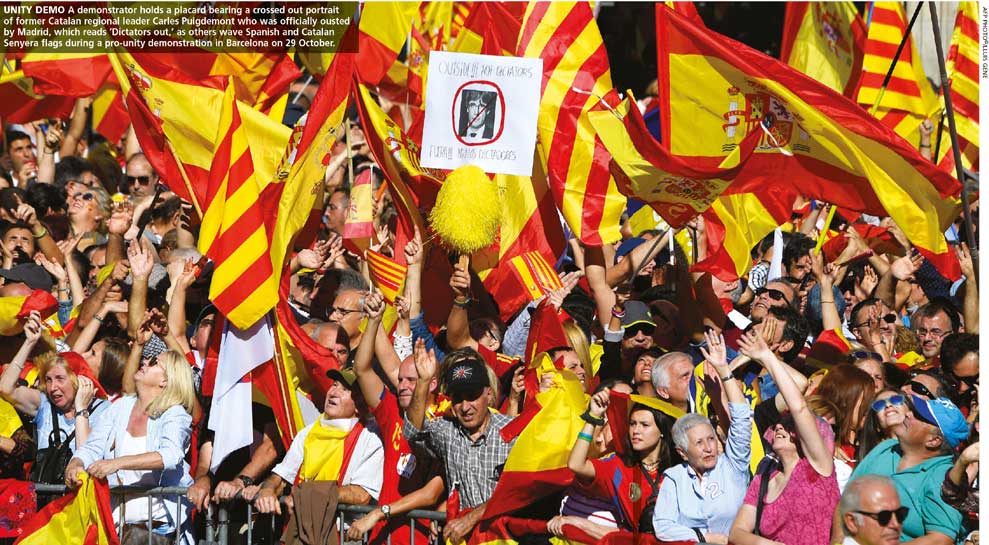SPAIN IN CRISIS
CATALEXIT IN THE MAKING?
Rajika Jayatilake reports on Catalonia’s referendum seeking independence from Spain

Secession within national boundaries is a tantalising but deadly mirage that communities pursue time and again. The latest territory to attempt secession within national boundaries is Catalonia, following the 1 October referendum held in the semi-autonomous region in Spain’s southeastern corner.
Catalonia has the trappings of an independent nation: its own parliament, language, flag, anthem, police force, and certain public services like healthcare and education.
Although Madrid’s constitutional court declared the referendum illegal and invalid, and police violence was used to suppress it, Cataloniarefused to succumb. Around 2.3 million of its 7.5 million people voted while anti-independence supporters abstained. Subsequently, the regional government announced that 90 percent of voters favoured separation.
Following the outcome, the President of the then Government of Catalonia Carles Puigdemont signed a symbolic declaration of independence although he promptly suspended its implementation to enable Catalonia to negotiate with Spain.
However, Spanish Prime Minister Mariano Rajoy told Spain’s parliament that he wasn’t willing to negotiate the break up of Spain and issued an ultimatum to Puigdemont to renege on his quest for secession. Since this call wasn’t heeded, Madrid employed a hitherto unused constitutional amendment to sack Puigdemont and his cabinet, suspend regional autonomy and assume direct control over Catalonia.
Puigdemont fled to Belgium with 13 of his former ministers, and they’re now facing charges in Spanish courts relating to sedition and misuse of public funds. Puigdemont has refused to return to Spain to testify, and Spain’s High Court has in turn issued an arrest warrant for the group – its charge of rebellion carries a 30 year prison sentence.
With a unique history dating back almost a thousand years, Catalonia has had a turbulent relationship with Spain. Once an independent region of the Iberian Peninsula, it became part of Spain with the merging of kingdoms in the 15th century. However, many Catalans assume they’re a nation in their own right.
General Francisco Franco who ruled Spain from 1939 until his death in 1975 tried to destroy attempts of Catalan separatism. However, with Franco’s passing and the return of democracy to Spain in 1977, Catalonia was once again granted a degree of autonomy.
Spain is a highly decentralised unitary state with limited self-government devolved on 17 ‘autonomous communities’ (created in line with Spain’s 1978 constitution) of which Catalonia is one. In 2006, Catalonia passed a statute granting itself greater power and financial independence as a ‘nation.’ After four years of deliberations, Spain’s Constitutional Court rejected the concept of a ‘Catalonian nation,’ which angered Catalans who staged mass protests.
Catalonia is one of Spain’s wealthiest and most productive regions. With 16 percent of Spain’s population, it accounts for 19 percent of its GDP and over a quarter of exports. About 18 million of Spain’s 75 million tourists chose Catalonia as their primary spot for a vacation last year.
The Catalan province of Tarragona is home to one of Europe’s largest chemical hubs while Barcelona is a leading EU port. Time has reported that Catalonia pays US$ 12 billion more taxes to Madrid annually than Madrid returns to it while Andalusia – Spain’s poorest region – receives around US$ 9.5 billion more than it pays Madrid. ‘Madrid nos roba’ (Madrid is robbing us) was a popular secessionist slogan.
But reality is harsh and relentlessly practical. If Catalonia becomes a separate state, it will have to take over defence, international relations, border control and customs, and establish its own central bank and tax authority. And the Catalan government’s public debt (around US$ 90 billion) would have to be repaid to Madrid.
With economic uncertainty and the prospect of independence, two banks in Catalonia relocated their head offices and over 500 companies moved their registered addresses to other regions. In the meantime, Barcelona’s tourism industry has suffered.
Two-thirds of Catalonia’s exports are to the EU so if it secedes from Spain, it would have to reapply for membership. In 2015, the Bank of Spain warned Catalonia that independence would mean it’ll forgo access to the euro.
Spain has made it clear there is no room for secession. Rajoy has called for a snap election in December and promised to “restore legality” to the region. Having earlier asked Catalans to resist the central government’s “repression and threats,” Puigdemont has accepted the poll even though his arrest warrant means he cannot stand for election.
Catalonia’s demands for secession has led to a constitutional crisis in Spain and created a headache for the European Commission. Fearful of setting a precedent, the President of the European Commission Jean-Claude Juncker isn’t backing Catalan independence. “I wouldn’t like a European Union in 15 years that consists of some 90 states,” he has said.
Whatever the ultimate outcome, the Catalonian situation shows the futility of demanding secession within the boundaries of a unitary nation. Abraham Lincoln put it succinctly in his inaugural address as the 16th President of the United States: “No state, upon its own mere motion, can lawfully get out of the Union… Plainly, the central idea of secession is the essence of anarchy.”



